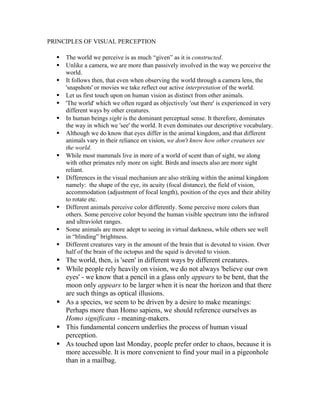
Principles of visual perception
- 1. PRINCIPLES OF VISUAL PERCEPTION The world we perceive is as much “given” as it is constructed. Unlike a camera, we are more than passively involved in the way we perceive the world. It follows then, that even when observing the world through a camera lens, the 'snapshots' or movies we take reflect our active interpretation of the world. Let us first touch upon on human vision as distinct from other animals. 'The world' which we often regard as objectively 'out there' is experienced in very different ways by other creatures. In human beings sight is the dominant perceptual sense. It therefore, dominates the way in which we 'see' the world. It even dominates our descriptive vocabulary. Although we do know that eyes differ in the animal kingdom, and that different animals vary in their reliance on vision, we don't know how other creatures see the world. While most mammals live in more of a world of scent than of sight, we along with other primates rely more on sight. Birds and insects also are more sight reliant. Differences in the visual mechanism are also striking within the animal kingdom namely: the shape of the eye, its acuity (focal distance), the field of vision, accommodation (adjustment of focal length), position of the eyes and their ability to rotate etc. Different animals perceive color differently. Some perceive more colors than others. Some perceive color beyond the human visible spectrum into the infrared and ultraviolet ranges. Some animals are more adept to seeing in virtual darkness, while others see well in “blinding” brightness. Different creatures vary in the amount of the brain that is devoted to vision. Over half of the brain of the octopus and the squid is devoted to vision. The world, then, is 'seen' in different ways by different creatures. While people rely heavily on vision, we do not always 'believe our own eyes' - we know that a pencil in a glass only appears to be bent, that the moon only appears to be larger when it is near the horizon and that there are such things as optical illusions. As a species, we seem to be driven by a desire to make meanings: Perhaps more than Homo sapiens, we should reference ourselves as Homo significans - meaning-makers. This fundamental concern underlies the process of human visual perception. As touched upon last Monday, people prefer order to chaos, because it is more accessible. It is more convenient to find your mail in a pigeonhole than in a mailbag.
- 2. Similarly to our desire to organize the external world in order to make it more accessible, we tend to organize the information we perceive into coherent and cohesive units, at the moment of perception. This type of organization is automatic and subconscious. The most common type of subconscious organization is that of analogy or comparison. If we can find similarity between two perceived entities , we can place them both in a single category. As more analogous information is perceived, comparisons between “more similar” entities warrants further categorization (smaller pigeon holes). The more we are capable of, and the more we allow ourselves, to discriminate, the greater the number of categories we form. The less we care to discriminate, the smaller our world is. Categorization is a key 'top-down' process which is involved in perception. Categories simplify. Categorization has a number of functions: The cost of these advantages is a loss of particularity and uniqueness in perception and recall. it makes complexity manageable; it speeds up recognition; it reduces effort and learning; it makes the most of past experience; it enables the inferences about further attributes (going beyond what is 'given'); it makes events predictable; it supports systematization; it bonds social behaviour (providing shared frameworks); it tailors the world to our purposes; it makes the world seem more meaningful. For Romantics, it is also regarded as inducing a sense of distance from the world. The way we categorize phenomena seems to be a 'natural' 'reflection of reality', leading us to forget the role of categorization in constructing the world. Probably the most well-known example of the cultural diversity of categories is that Eskimos have dozens of words for 'snow' - an assertion which is frequently attributed to Benjamin Lee Whorf. Actually, Whorf seems never to have claimed that Eskimos had more than five words for snow (Whorf 1956, 216). However, a more recent study - not of the Inuit but of the Koyukon Indians of the subarctic forest - does list 16 terms for snow, representing these distinctions:
- 3. snow deep snow falling snow blowing snow snow on the ground granular snow beneath the surface hard drifted snow snow thawed previously and then frozen earliest crusted snow in spring thinly crusted snow snow drifted over a steep bank, making it steeper snow cornice on a mountain heavy drifting snow slushy snow on the ground snow caught on tree branches fluffy or powder snow (Nelson 1983, 262-3) When we are tired, we tend to discriminate less, and as a result we make fewer associations between perceived entities. Generally, quantitatively, we “create” less. Qualitatively, however, we may associate things that might otherwise pass us by for moving too quickly, or for taking things for granted. People on drugs at times seem to have some unique creative moments. Often, when re-examined, they seem more as the “mastery of the obvious” There are several types of associative mechanisms that can be “associated” with creativity. Faced even by 'meaningless' patterns the mind restlessly strives to make them meaningful.
